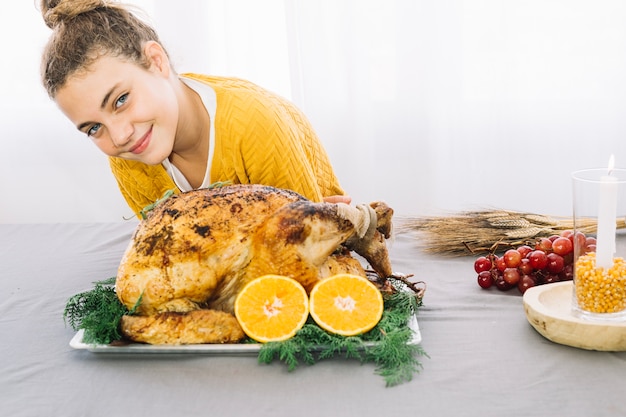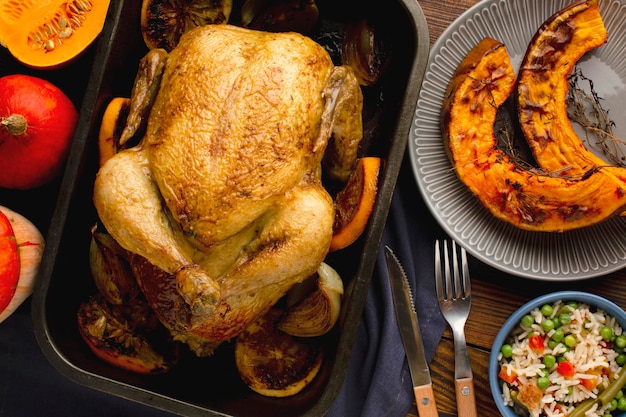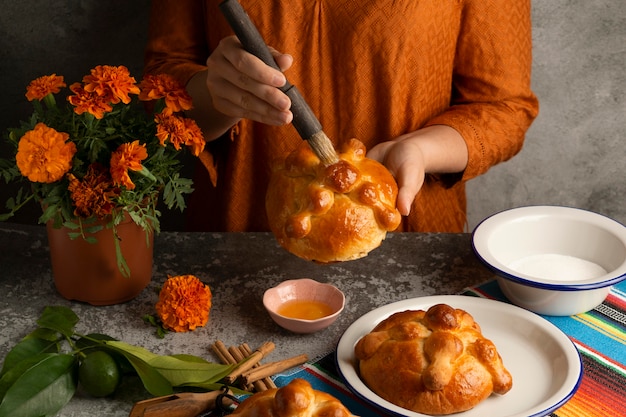Let's talk turkey, folks! I'm not talking about the bird itself, although that's certainly a big part of it. I'm talking about the whole shebang – the excitement, the anticipation, and maybe even a little bit of trepidation that comes with cooking a turkey in the oven. It's one of those things that's both exhilarating and daunting. You want that perfectly cooked, juicy bird, bursting with flavour. The kind that gets everyone raving and leaving you feeling like a culinary superstar.
And let me tell you, I've been there - the burnt bird, the dry meat, the sheer panic that sets in as you realize you've underestimated the cooking time. But fret no more! I've battled my way through the turkey trenches, and I'm here to guide you towards a triumphant Thanksgiving or Christmas dinner, free from culinary anxieties.
This guide is your one-stop shop for everything you need to know about cooking a turkey in the oven. We'll dive deep into the world of turkeys, from selecting the right bird to mastering the art of roasting and achieving that perfect golden-brown crust. We'll cover everything from prepping the turkey to mastering the art of basting, and finally, we'll tackle the all-important resting and carving techniques.
Get ready for a journey into the heart of turkey cooking, packed with practical tips, helpful advice, and even a dash of personal anecdotes. So, grab your favourite beverage, get comfy, and let's get started!
(Part 1) The Turkey: Your Star Ingredient

Choosing Your Turkey: A Star is Born
The turkey is the star of the show, so choosing the right one is crucial. Don't just grab the first one you see. Take your time and choose wisely, just like you would when picking the perfect outfit for a special occasion! Here's what to look for:
- Size Matters: First things first, how many mouths are you feeding? A good rule of thumb is to allow about 1 pound of turkey per person. So, if you're expecting 10 guests, a 10-pound turkey will do the trick. A 12-pound turkey will give you some leftovers for sandwiches later, and that’s always a good thing, in my book.
- Weight Check: Don't be shy about getting your hands a little dirty and giving the turkey a good feel. You want a turkey that feels firm and plump, not squishy or soft. A turkey that feels light for its size might have been frozen and thawed repeatedly, which could affect the flavour and texture.
- Appearance is Everything: The skin should be smooth and free of any discoloration or tears. Avoid turkeys that have a strong odour or any signs of freezer burn. It's better to be safe than sorry.
- Packaging Matters: Always check the packaging for any signs of leakage or damage. The turkey should be well-wrapped and frozen solid. You don’t want any surprises when you get home.
Thawing Your Turkey: A Patient Process
Now, you've got your turkey, and it's time to thaw it. The best way to thaw a turkey is slowly in the refrigerator. It takes a while – about 24 hours for every 5 pounds of turkey. So, for a 10-pound turkey, you'll need about 48 hours. Patience is key here! If you're short on time, you can thaw a turkey in cold water, but make sure it’s completely submerged and change the water every 30 minutes. This method is much quicker, but it’s not ideal. I always recommend using the refrigerator method for best results.
Preparing Your Turkey: The Pre-Show Ritual
Your turkey is thawed, and you're ready to prep it for its big moment. It's like getting your star ready for the spotlight – a little bit of TLC can make a world of difference.
- Rinse and Pat Dry: Start by rinsing the turkey inside and out with cold water. Then, pat it dry thoroughly with paper towels. This ensures that the skin gets crispy and golden brown, just like a perfectly roasted potato.
- Stuffing: The Great Debate: Stuffing is a bit of a controversial topic, to be honest. Some people swear by it, while others prefer to avoid it altogether. If you're a stuffing enthusiast, do it right before putting the turkey in the oven. Make sure it's cooked to 165°F for food safety. You can also stuff the turkey cavity with aromatics like onions, celery, and carrots, which will add depth and complexity to the flavour of your turkey.
- Seasoning: The Flavour Boost: Don't be shy with the seasoning! Salt, pepper, herbs, and spices can transform a plain turkey into a culinary masterpiece. Experiment with your favourite combinations, and don't forget to add a little bit of butter under the skin to keep the meat moist.
- Tie Up the Legs: Use kitchen twine to tie the turkey legs together. This helps to keep the turkey moist and even-shaped while it roasts, preventing the legs from drying out.
(Part 2) Roasting Your Turkey: The Art of Oven Cooking

The Oven: Your Roasting Arena
Your turkey is prepped and ready to go. Now, it's time to focus on the oven, the centrepiece of this culinary operation. Preheating your oven is essential, just like warming up before a workout. Get that oven nice and hot, to about 325°F (160°C), before you even think about putting the turkey in. This ensures even cooking and helps the turkey develop a beautiful golden-brown crust.
The roasting pan: Your Turkey's Throne
The roasting pan is your turkey's throne, so choose a pan that's big enough to hold the turkey comfortably, with a little bit of space around it. I always prefer to use a roasting pan with a rack, as it allows air to circulate around the turkey, leading to more even cooking and a crispy skin.
Putting It All Together: The Grand Assembly
You've got a preheated oven, a roasting pan, and your beautifully prepped turkey. Now, it's time to put it all together:
- Place the Turkey: Carefully place the turkey in the roasting pan, breast side up.
- Add Liquid: Pour a cup of broth or water into the bottom of the pan. This helps keep the turkey moist and prevents the bottom from burning, ensuring a juicy and flavorful bird.
- Cover the Turkey: Cover the turkey loosely with foil. This helps keep the turkey moist and prevents it from drying out, especially during the initial stages of roasting.
- Roast the Turkey: Pop that turkey into the preheated oven and let it roast! This is where the real magic happens. But, don't go off and watch TV just yet! We're not quite done yet.
(Part 3) The roasting time: Decoding the Bird's Internal Clock

Now we get to the crucial part – the roasting time. It's the moment we decipher the turkey's internal clock to achieve that perfect level of doneness. But don't worry, I've got you covered.
Calculating the Roasting Time: A General Guide
Here's the general rule of thumb:
Unstuffed turkey: Roast for 13 minutes per pound at 325°F.
Stuffed turkey: Roast for 15 minutes per pound at 325°F.
However, remember that the weight isn't the only factor. You also need to consider the size and shape of the turkey. A wider turkey might take a little longer than a thinner one. And just to be sure, don't rely solely on the time – always use a trusty meat thermometer. It’s the best way to know if your turkey is cooked to perfection.
The Meat Thermometer: Your Turkey's Personal Doctor
The meat thermometer is your best friend when it comes to turkey. It takes the guesswork out of cooking and ensures that your turkey is cooked safely and to perfection. Here's what you need to know:
Insert the Thermometer: Insert the thermometer into the thickest part of the thigh, making sure it doesn't touch any bones.
Check the Temperature: The turkey is done when the internal temperature reaches 165°F (74°C) in the thickest part of the thigh.
Time for Basting: Keeping the Turkey Moist
Every hour or so, take a moment to baste the turkey with pan drippings. It’s like giving your turkey a little bit of extra love, ensuring that it stays moist and flavorful throughout the cooking process. You can also add a little bit of butter or broth to the pan for extra moisture, which will enhance the richness and flavour of your turkey.
(Part 4) The Final Countdown: Signs of a Perfectly Cooked Turkey
The moment you’ve been waiting for has arrived: the turkey is done! But how do you know? Here are some telltale signs:
- Internal Temperature: The most important sign is the internal temperature. As mentioned before, the turkey is done when the internal temperature reaches 165°F (74°C) in the thickest part of the thigh.
- The Thigh Juice: If you poke the thigh, the juices should run clear. If they're still pink, the turkey needs to cook a bit longer.
- The Skin: The skin should be golden brown and crispy. It's the hallmark of a perfectly roasted turkey.
- The Bones: The drumstick should move easily and the leg bones should be loose.
(Part 5) Resting: Letting the Turkey Relax
Don't be tempted to carve the turkey right away! Let it rest for 15-20 minutes before carving. This gives the juices a chance to redistribute throughout the meat, resulting in a more juicy and flavorful turkey. Cover the turkey loosely with foil to keep it warm and prevent it from drying out.
(Part 6) Carving: A Culinary Performance
Carving the turkey can seem intimidating, but it's actually quite simple. Here's what you need to do:
- Remove the Turkey: Carefully remove the turkey from the roasting pan and place it on a cutting board.
- Separate the Legs: Cut through the skin between the thigh and the body. Then, cut through the joint connecting the thigh and the drumstick. You can separate the drumstick and thigh individually, or leave them attached.
- Remove the Wings: Cut through the joint connecting the wings to the body. You can save the wings for a delicious turkey soup or stock later.
- Carve the Breast: Use a carving knife to cut the breast meat in thin slices. If you have a whole breast bone, you can remove it before slicing the meat.
- Serve: Arrange the turkey slices on a platter and serve with your favourite sides.
(Part 7) Leftovers: Turning Turkey into Treasure
The magic of leftovers! There's nothing quite like a turkey sandwich the next day, and there's no need to let those leftovers go to waste. Get creative and turn those turkey scraps into culinary treasures!
- turkey salad: Mix shredded turkey with mayonnaise, celery, onion, and your favourite seasonings. This is a classic and always a crowd-pleaser.
- turkey soup: Use leftover turkey meat in a hearty soup with broth, vegetables, and noodles. A warming and comforting dish perfect for chilly evenings.
- Turkey Chili: Make a chili with turkey meat, beans, tomatoes, and your favourite spices. A hearty and flavorful option that's perfect for a cold winter's day.
- Turkey Pizza: Add shredded turkey to your favourite pizza dough with marinara sauce, cheese, and other toppings. A delicious and unexpected twist on classic pizza.
- Turkey Enchiladas: Use shredded turkey in enchiladas with a corn tortilla, cheese, and a spicy tomato sauce. A flavourful and satisfying dish that's perfect for a quick and easy meal.
(Part 8) Tips and Tricks: Mastering the Art of Turkey Cooking
I've learned a few things over the years about cooking turkeys. Here are some tips and tricks that I think might come in handy:
- Brine the Turkey: Soaking the turkey in a salt-water solution called a brine can help keep the turkey moist and flavorful. This is a great trick, especially if you're using a smaller or leaner turkey.
- Don't Overcook: It's better to slightly undercook the turkey than overcook it. You can always reheat it, but you can't uncook it.
- Don't Stuff the Turkey: If you want to stuff the turkey, make sure it's cooked to 165°F in the thickest part of the stuffing. It's generally safer to cook the stuffing separately, in a casserole dish.
- Rest the Turkey: Let the turkey rest for 15-20 minutes before carving, so the juices can redistribute.
- Make Gravy: Use the pan drippings to make a delicious gravy. Add a tablespoon or two of flour to the pan drippings, whisk well, and slowly add some broth or water, stirring constantly until the gravy thickens.
(Part 9) FAQs: Addressing Your Turkey Conundrums
1. What if My Turkey is Overcooked?
Don't panic! If you've overcooked the turkey, it won't be ruined. It'll be a bit dry, but you can still make a delicious meal. Just serve it with a rich gravy, and consider using the turkey meat in a soup, stew, or chili the next day.
2. Can I Cook a Turkey in a slow cooker?
You can, but it's not the best method for cooking a whole turkey. A slow cooker is great for smaller cuts of meat, but it can take a very long time to cook a whole turkey. If you're set on using a slow cooker, check out recipes specifically designed for cooking turkeys in slow cookers.
3. Can I Cook a frozen turkey?
It’s not recommended. If you have to, you can cook a frozen turkey, but it will take longer. It’s best to thaw the turkey completely in the refrigerator first. The texture will be better, and it’s safer too.
4. What’s the Difference Between a Fresh and a Frozen Turkey?
A fresh turkey is one that has never been frozen. A frozen turkey has been frozen and then thawed. They both taste good! The main difference is in the texture. A fresh turkey tends to be a bit more tender.
5. What Should I Serve with My Turkey?
This is the fun part! There are so many delicious side dishes that go great with turkey. Some of my favourites include:
mashed potatoes: Creamy and comforting, the perfect side for any turkey meal.
Stuffing: A classic, and so versatile. You can use bread, rice, or even wild rice for a more earthy flavour.
green bean casserole: A Thanksgiving staple, perfect for adding a touch of nostalgia to your table.
Cranberry Sauce: Tart and tangy, it balances the richness of the turkey beautifully.
Gravy: You can't have turkey without gravy!
(Part 10) Conclusion: The Ultimate Turkey Triumph
And there you have it! Your ultimate guide to cooking a turkey in the oven. With this guide, you’re equipped to conquer Thanksgiving, Christmas, or any other festive occasion. Remember, it’s all about having fun in the kitchen. So, get creative, enjoy the process, and savour every moment. Who knows? You might just become the next turkey-roasting champion.
Everyone is watching

How to Cook Frozen Lobster Tails Perfectly: A Step-by-Step Guide
RecipesLobster. Just the word conjures up images of lavish meals, special occasions, and a taste of luxury. But let's...

Pigs in a Blanket Cooking Time: How Long to Bake for Perfect Results
RecipesAh, pigs in a blanket. Just the name conjures up images of those delightful little parcels of crispy pastry en...

Pork Fillet Cooking Time: How Long to Cook It Perfectly
RecipesPork fillet, or tenderloin as it's sometimes called, is a real favourite in our house. It's so versatile, and...

The Ultimate Guide to Tender, Juicy Pulled Pork
RecipesRight, let's talk pulled pork. It's one of those dishes that just screams "comfort food," doesn't it? I mean...

The Ultimate Guide to Cooking Sweet Potatoes: From Roasting to Mashing
RecipesSweet potatoes. Just the name conjures up images of warm, comforting dishes, bursts of vibrant color, and a to...
